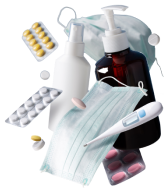-
Description
It conatins; Prioglitazone and Glimepiride as its active components. Pioglitazone is a Thiazolidinedione antidiabetic medicine that decreases blood glucose by improving target cell response to insulin, without increasing pancreatic insulin secretion. Its action depends on the presence of insulin for activity. Pioglitazone is a strong and selective agonist for peroxisome proliferator-activated receptor-gamma (PPAR-gamma). Activation of these effects results in the production of a number of gene products that are involved in glucose and lipid metabolism. The interaction between Pioglitazone and these receptors result in the reduction in glucose levels, free fatty acids and decrease in tumor necrosis factor alpha, which is a chemical mediator of inflammation. This medicine has an advantage over others that it does not usually cause hypoglycemia when given alone (not with other hypoglycemic agents). Glimepiride is an insulin secretagogue, this drug is only effective in patients with residual pancreatic beta-cell activity. Glimepiride acts at ATP-dependent potassium channels on the cell membrane of pancreatic beta cells, resulting in iatrogenic depolarization by prevention of potassium from cell excitation. This depolarization activates voltage-dependent calcium channels on the cell membrane, resulting in an increase in intracellular calcium levels and increase in subsequent exocytosis of insulin into the bloodstream. Insulin now acts on cell membrane receptors and triggers GLUT-4 expression and glucose movement into the cell, this mechanism lowers blood glucose levels. Glimepiride interacts with Epac3, a nucleotide exchanger that works by mediating the exocytosis of insulin granules. Glimepiride is an oral blood-glucose-lowering drug of the sulfonylurea class. It can be used concomitantly with other drugs for glycemic control like metformin and also along with insulin. But its use along with insulin can cause hypoglycemia (low level of glucose). Used as an adjunct to diet and exercise to lower the blood glucose (sugar) in patients with noninsulin-dependent (Type 2) diabetes mellitus whose hyperglycemia (high level of glucose) cannot be controlled by diet and exercise alone.
-
Ingredients
Glimepiride 2mg, Pioglitazone 30mg
-
Dosage Form
-
Uses
Glimepiride, Pioglitazone combination is utilized for the following therapeutic indications:
- Type 2 diabetes management
- Improvement of insulin sensitivity
- Enhancement of glycemic control
- Reduction of fasting blood glucose levels
- Support for metabolic health
-
Dosage
Dose must be taken according to the doctor’s advice only; doses given below are suggested as supportive literature for better understanding in some areas of requirements. Adult dose: For Type 2 Diabetes Mellitus(as monotherapy or with insulin or insulin secretagogues); initial dose is 15-30mg orally a day with meal; you may increase the dose by 15mg with careful monitoring, maximum dose is 45mg a day.
-
In case of Overdose
Overdosage of this drug can produce hypoglycemia. Mild hypoglycemic symptoms without loss of consciousness or neurologic findings should be treated aggressively with oral glucose and adjustments in drug dosage and/or meal patterns. Close monitoring should continue until the physician is assured that the patient is out of danger.
-
Missed Dose
In case you missed any dose, take the next dose as soon as you remember, but don't double your next dose to compensate for the missed one.
-
How To Use
Take orally with water in the morning or evening, swallow as such, do not chew.
-
When Not to Use
Pioglitazone cannot be used in patients with symptomatic heart failure. Initiation of pioglitazone in patients with established New York Heart Association (NYHA) class III or IV heart failure is not recommended. Do not use in case of hypersensitivity to pioglitazone or any component of the formulation. Avoid the use of pioglitazone in serious hepatic impairment, active bladder cancer, history of bladder cancer, uninvestigated macroscopic hematuria and pregnancy. Pioglitazon is is not recommended for patients with type 2 diabetes mellitus planning to become pregnant. This drug is contraindicated in patients with known hypersensitivity to the Glimepiride and in patients with diabetic ketoacidosis, with or without coma. This condition should be treated with insulin. It must not be recommended for use in pregnancy or nursing mothers. Data are insufficient to recommend pediatric use of this drug.
-
Side Effects
Increase in risks of bladder carcinoma May increase the risk of bone fractures Edema Upper respiratory tract infection Cardiac failure Headache Back pain Myalgia Sinusitis Pharyngitis Increased creatine phosphokinase in blood specimen Increased serum alanine aminotransferase Weight gain (probably due to fluid retention and weight gain) Dizziness Asthenia(extreme fatigue) Headache Nausea Vomiting Gastrointestinal pain Diarrhea Urticaria Photosensitivity reactions Hyponatremia Syndrome of inappropriate antidiuretic hormone (SIADH) secretion Allergic vasculitis (inflammation of blood vessels) Leukopenia Agranulocytosis Thrombocytopenia Hemolytic anemia Aplastic anemia Pancytopenia have also been reported with sulfonylureas Including Glimepiride
-
Precautions & Warnings
Thiazolidinediones like; pioglitazone which can cause congestive heart failure (CHF) in some patients. After initiating use of pioglitazone, and after increase in dose, observe patients carefully for signs and symptoms of heart failure (including excessive, rapid weight gain, dyspnea, and/or edema). If these signs and symptoms occur, manage the heart failure according to set standards of care. Discontinuation or reduction in dose of pioglitazone must be considered. Pioglitazone may cause ovulation (the release of an egg) in anovulatory (cause of infertility) premenopausal (woman's menstrual periods stop permanently) patients, and increases the risk of unintended pregnancy. Administration of oral hypoglycemic drugs has been reported to be linked with increased cardiovascular mortality (deaths due to heart disease) as compared to treatment with diet alone or diet plus insulin. The patient should be informed of the potential risks and advantages of Glimepiride use.
-
Food Interactions
Maitake (a mushroom) may increase the hypoglycemic (glucose/sugar lowering) effect of Pioglitazone . Avoid the use of grapefruit with Pioglitazone as it will increase the level or effect of pioglitazone oral by altering drug metabolism.
-
Storage/Disposal
Store below 25°C, at a dry place.
-
Laboratory Screening
If you are diabetic, go for the following tests: Glucose Tolerance Test, Blood sugar test, and Blood Glucose Fasting Test. If you want to monitor your heart health then go for; ECG

